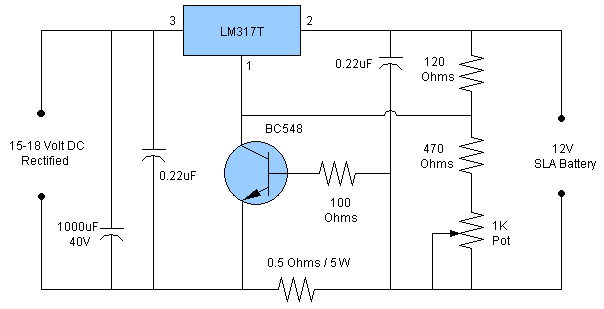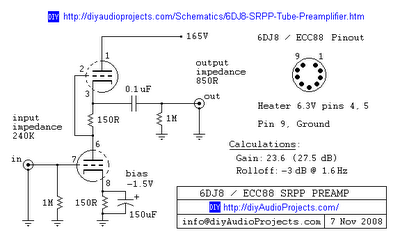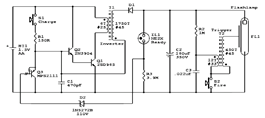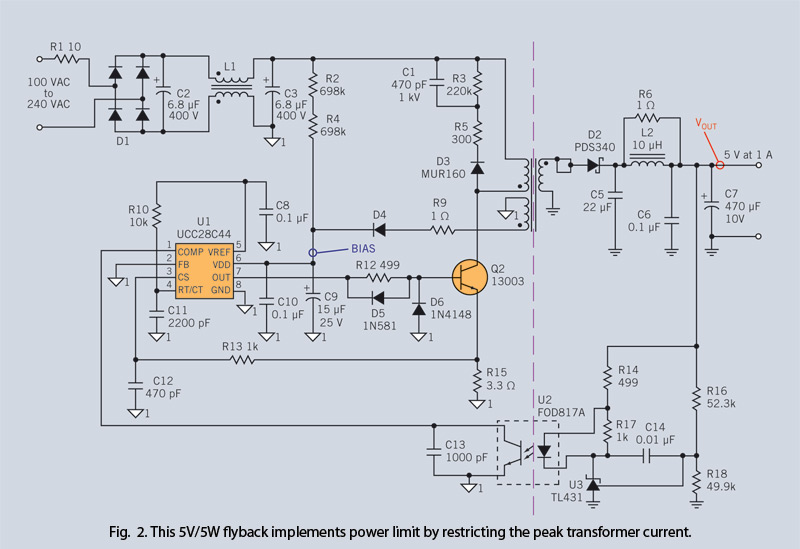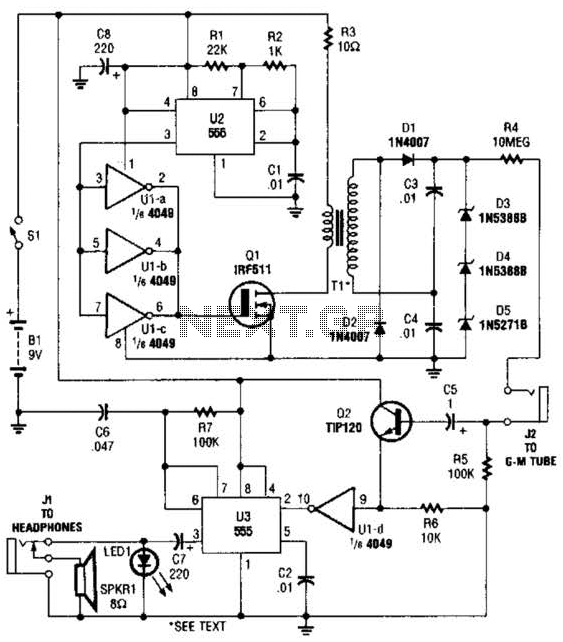
Differential circuit with constant current
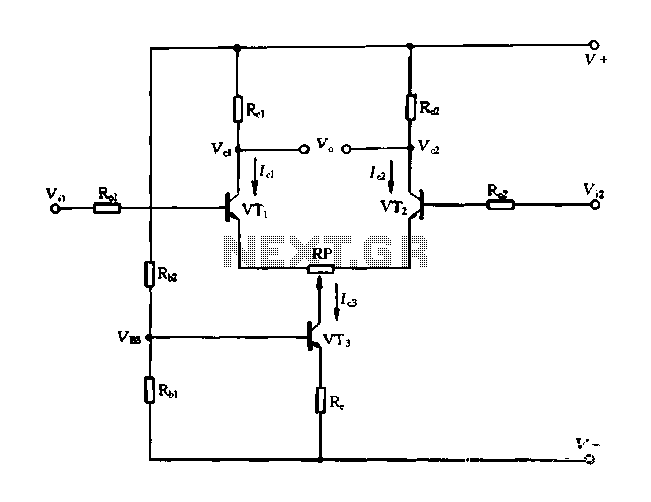
A differential amplifier with a constant current source is illustrated in Figure 1-27. As long as capacitor C3 is maintained at a constant value, capacitors C1 and C2 cannot be simultaneously increased or decreased, preventing voltage drift. The differential circuit input signal can be processed in four distinct configurations: double-ended input with double-ended output; double-ended input with single-ended output; single-ended input with double-ended output; and single-ended input with single-ended output, as depicted in Figure 1-28. The amplification can be configured in four ways: regardless of the method of access, if a single-ended output is used, the gain of the basic amplification circuit is halved. In the case of double-ended output, the gain closely resembles that of the basic amplifier circuit. The differential amplifier circuit typically serves as the input stage of the pre-stage amplifier circuit, ensuring that its output is always aligned with this amplification circuit. While utilizing a single-ended output differential circuit poses no issues, the double-ended output differential circuit presents challenges. Although it features two outputs, there is no common terminal between the input signal and the single-ended output, which limits the advantages of the differential circuit. Therefore, a matching circuit to convert double-ended to single-ended output is required, represented by the current mirror circuit shown in Figure 1-29. In this figure, transistors VT3 and VT4 form the current mirror source, leading to the relationship: Ic3 = Id and Ic4 = Id - Ic2. When the common mode input is applied (where both input terminals receive equal amplitude signals), the current Ic2 is zero, resulting in the same double-ended output. For differential input (where the two input terminals receive equal magnitude signals of opposite polarity), the relationship can be expressed as Ic1 = -Ic2. In this differential input scenario, the output current is effectively a single-tube double current output, which is also applicable to double-ended output configurations. The circuit schematic discussed will be encountered in subsequent examples.
The differential amplifier with a constant current source is a critical component in analog signal processing. It operates by amplifying the difference between two input voltages while rejecting any signals that are common to both inputs, which is essential in minimizing noise and improving signal integrity. The arrangement of capacitors C1, C2, and C3 plays a vital role in stabilizing the amplifier's performance by controlling the bias currents and preventing drift due to temperature variations or component tolerances.
The four configurations for input and output processing allow for versatile applications, adapting the amplifier to various signal types and system requirements. The choice between single-ended and double-ended outputs influences the design of the subsequent stages in the signal chain, particularly in terms of impedance matching and noise considerations. The current mirror circuit, formed by transistors VT3 and VT4, is crucial for maintaining a stable output current, ensuring that variations in input signal amplitude do not adversely affect the amplifier's performance.
In practical applications, the differential amplifier is often used in instrumentation, audio processing, and communication systems, where precise signal amplification is required. The design considerations for such amplifiers include bandwidth, gain accuracy, and linearity, which are essential for maintaining fidelity in signal reproduction. The integration of a current mirror allows for improved performance by providing a consistent current source, thus enhancing the amplifier's dynamic range and overall efficiency.Differential amplifier with a constant current source, as shown in Figure 1-27. Thus, as long as, c3 and kept constant, cl, n can not be simultaneously increased or reduced sim ultaneously, thus inhibiting the voltage drift. Their differential circuit input signal, the output is divided into four different ways: double-ended input, double-ended output; double-ended input into a single-ended output; single-ended input, double-ended output; single-ended input, single-ended output. As shown in Figure 1-28. Magnification can be connected in four umbrella is: regardless of access method, as long as a single-ended output, the magnification of the basic amplification circuit half; if it is double-ended output, the magnification and the same basic amplifier circuit o differential amplifier circuit is almost always pre-stage amplifier circuit input section o Therefore, its output is always going to base this amplification circuit.
This single-ended output differential circuit is not a problem, while the double-ended output differential circuit would be inconvenient o because although it has two outputs, but not between the input signal and the common terminal, the single end output, you can not play to the advantages of the differential circuit. Hence the need for a double-ended to single output terminal matching circuit, which is the mirror current source circuit shown in Figure 1-29.
In Figure 1-29, VT3, VT4 constitute a mirror current source, therefore: Ic, 3 J d, and, c3 - Icl, so: Ic4 Icl output current D o Id - lc2 Icl - Ic2 0 when the common mode input (input terminal when two equal amplitude signals to common mode input), I {: 1 Ic2 so f. A, c2 0 and the same double-ended output. Differential input (two input terminal input equal in magnitude and opposite polarity signals, called differential mode input): Icl FIcl a Icl, Ic2 F, c2 + Ic2 because Icl F, spit so.
F2AlC. That differential input, the output current is a single-tube double current output, and also double-ended output the same. In the example above the circuit schematic will encounter later.
The differential amplifier with a constant current source is a critical component in analog signal processing. It operates by amplifying the difference between two input voltages while rejecting any signals that are common to both inputs, which is essential in minimizing noise and improving signal integrity. The arrangement of capacitors C1, C2, and C3 plays a vital role in stabilizing the amplifier's performance by controlling the bias currents and preventing drift due to temperature variations or component tolerances.
The four configurations for input and output processing allow for versatile applications, adapting the amplifier to various signal types and system requirements. The choice between single-ended and double-ended outputs influences the design of the subsequent stages in the signal chain, particularly in terms of impedance matching and noise considerations. The current mirror circuit, formed by transistors VT3 and VT4, is crucial for maintaining a stable output current, ensuring that variations in input signal amplitude do not adversely affect the amplifier's performance.
In practical applications, the differential amplifier is often used in instrumentation, audio processing, and communication systems, where precise signal amplification is required. The design considerations for such amplifiers include bandwidth, gain accuracy, and linearity, which are essential for maintaining fidelity in signal reproduction. The integration of a current mirror allows for improved performance by providing a consistent current source, thus enhancing the amplifier's dynamic range and overall efficiency.Differential amplifier with a constant current source, as shown in Figure 1-27. Thus, as long as, c3 and kept constant, cl, n can not be simultaneously increased or reduced sim ultaneously, thus inhibiting the voltage drift. Their differential circuit input signal, the output is divided into four different ways: double-ended input, double-ended output; double-ended input into a single-ended output; single-ended input, double-ended output; single-ended input, single-ended output. As shown in Figure 1-28. Magnification can be connected in four umbrella is: regardless of access method, as long as a single-ended output, the magnification of the basic amplification circuit half; if it is double-ended output, the magnification and the same basic amplifier circuit o differential amplifier circuit is almost always pre-stage amplifier circuit input section o Therefore, its output is always going to base this amplification circuit.
This single-ended output differential circuit is not a problem, while the double-ended output differential circuit would be inconvenient o because although it has two outputs, but not between the input signal and the common terminal, the single end output, you can not play to the advantages of the differential circuit. Hence the need for a double-ended to single output terminal matching circuit, which is the mirror current source circuit shown in Figure 1-29.
In Figure 1-29, VT3, VT4 constitute a mirror current source, therefore: Ic, 3 J d, and, c3 - Icl, so: Ic4 Icl output current D o Id - lc2 Icl - Ic2 0 when the common mode input (input terminal when two equal amplitude signals to common mode input), I {: 1 Ic2 so f. A, c2 0 and the same double-ended output. Differential input (two input terminal input equal in magnitude and opposite polarity signals, called differential mode input): Icl FIcl a Icl, Ic2 F, c2 + Ic2 because Icl F, spit so.
F2AlC. That differential input, the output current is a single-tube double current output, and also double-ended output the same. In the example above the circuit schematic will encounter later.
